Impacts of Thermal Time on Land Surface Phenology in Urban Areas
Abstract
:1. Introduction
2. Materials and Methods
2.1. Study Region
2.2. Data
2.2.1. MODIS Land Surface Temperature and Snow Cover Extent
2.2.2. Web-Enabled Landsat Data
2.2.3. National Land Cover Database
2.3. Methods
2.3.1. Spatial Arrangement of Urban Areas
2.3.2. Thermal Time
2.3.3. Land Surface Phenology Modeling
2.3.4. Equivalence Testing
2.3.5. Exponential Trend Model
3. Results
3.1. Equivalence Testing
Duration of Growing Season
3.2. Exponential Trend Model
3.3. Regional Comparison
4. Discussion
5. Conclusions
Acknowledgments
Author Contributions
Conflicts of Interest
Abbreviations
| AGDD | Accumulated Growing Degree-Days |
| AVHRR | Advanced Very High Resolution Radiometer |
| °C | Degrees Celsius |
| CONUS | Conterminous United States |
| DGSAGDD | Duration of Growing Season |
| DOY | Day of Year |
| EOS | End of Season |
| ETM+ | Enhanced Thematic Mapper Plus |
| EVI | Enhanced Vegetation Index |
| GCA | Green Core Area |
| GDD | Growing Degree-Day |
| ha | Hectare |
| half-TTPNDVI | NDVI at half-Thermal Time to Peak |
| IA | Iowa |
| ISA | Impervious Surface Area |
| km | Kilometer |
| LCT | Land Cover Type |
| LCZ | Local Climate Zone |
| LSP | Land Surface Phenology |
| LST | Land Surface Temperature |
| m | Meter |
| M | Million |
| MN | Minnesota |
| MODIS | Moderate Resolution Imaging Spectroradiometer |
| NASA | National Aeronautics and Space Administration |
| ND | North Dakota |
| NDVI | Normalized Difference Vegetation Index |
| NE | Nebraska |
| NLCD | National Land Cover Database |
| PHNDVI | Peak Height in NDVI |
| Q LSP | Quadratic Model of Land Surface Phenology |
| R2 | Coefficient of Determination |
| SD | South Dakota |
| SDs | Scientific Datasets |
| SOS | Start of Season |
| Tbase | Base Temperature |
| TM | Thematic Mapper |
| Tmax | Maximum Temperature |
| Tmin | Minimum Temperature |
| TOST | Two one-sided Tests |
| TTP | Thermal Time to Peak NDVI |
| UCA | Urban Core Area |
| UE | Urban Extent |
| UHI | Urban Heat Island |
| WELD | Web-Enabled Landsat Data |
References
- United Nations. World Urbanization Prospects: The 2005 Revision. Department of Economic and Social Affairs, Population Division 2006 (ST/ESA/SER.A/352). Available online: http://www.un.org/esa/population/publications/WUP2005/2005WUPHighlights_Final_Report.pdf (accessed on 20 January 2016).
- United Nations. World Urbanization Prospects: The 2014 Revision, Highlights. Department of Economic and Social Affairs, Population Division 2014, (ST/ESA/SER.A/352). Available online: http://esa.un.org/unpd/wup/highlights/wup2014-highlights.pdf (accessed on 20 January 2016).
- Seto, K.C.; Fragkias, M.; Güneralp, B.; Reilly, M.K. A meta-analysis of global urban land expansion. PLoS ONE 2011, 6. [Google Scholar] [CrossRef] [PubMed]
- Seto, K.C. Global urban issues: A primer. In Global Mapping of Human Settlement: Experiences, Datasets, and Prospects; Gamba, P., Herold, M., Eds.; Taylor and Francis Group, CRC Press: Boca Raton, FL, USA, 2009; pp. 3–9. [Google Scholar]
- Oke, T.R. Boundary Layer Climates, 2nd ed.; Methuen & Co.: London, UK, 1987. [Google Scholar]
- Chen, X.; Zhao, H.; Li, P.; Yin, Z. Remote sensing image-based analysis of the relationship between urban heat island and land use/cover changes. Remote Sens. Environ. 2006, 104, 133–146. [Google Scholar] [CrossRef]
- Hartmann, D.L.; Klein Tank, A.M.G.; Rusticucci, M.; Alexander, L.V.; Brönnimann, S.; Charabi, Y.; Dentener, F.J.; Dlugokencky, E.J.; Easterling, D.R.; Kaplan, A.; et al. Observations: Atmosphere and Surface. In Climate Change 2013: The Physical Science Basis, Contribution of Working Group I to the Fifth Assessment Report of the Intergovernmental Panel on Climate Change; Stocker, T.F., Qin, D., Plattner, G.K., Tignor, M., Allen, S.K., Boschung, J., Nauels, A., Xia, Y., Bex, V., Midgley, P.M., Eds.; Cambridge University Press: Cambridge, UK; New York, NY, USA, 2013; pp. 161–218. [Google Scholar]
- Voogt, J.A. Urban heat island. In Encyclopedia of Global Environmental Change; John Wiley & Sons: New York, NY, USA, 2002; pp. 660–666. [Google Scholar]
- Herold, M. Some recommendations for global efforts in urban monitoring and assessments from remote sensing. In Global Mapping of Human Settlement: Experiences, Datasets, and Prospects; Gamba, P., Herold, M., Eds.; Taylor and Francis Group, CRC Press: Boca Raton, FL, USA, 2009; pp. 11–27. [Google Scholar]
- Seto, K.C.; Güneralp, B.; Hutyra, L. Global forecasts of urban expansion to 2030 and direct impacts on biodiversity and carbon pools. Proc. Natl. Acad. Sci. USA 2012, 109, 16083–16088. [Google Scholar] [CrossRef] [PubMed]
- Seto, K.C.; Christensen, P. Remote sensing science to inform urban climate change mitigation strategies. Urban Clim. 2013, 3, 1–6. [Google Scholar] [CrossRef]
- De Beurs, K.M.; Henebry, G.M. Land surface phenology, climatic variation, and institutional change: Analyzing agricultural land cover change in Kazakhstan. Remote Sens. Environ. 2004, 89, 497–509. [Google Scholar] [CrossRef]
- Schwartz, M.D.; Betancourt, J.L.; Weltzin, J.F. From Caprio’s lilacs to the USA National Phenology Network. Front. Ecol. Environ. 2012, 10, 324–327. [Google Scholar] [CrossRef]
- White, M.A.; Nemani, R.R.; Thornton, P.E.; Running, S.W. Satellite evidence of phenological differences between urbanized and rural areas of the eastern United States deciduous broadleaf forest. Ecosystems 2002, 5, 260–273. [Google Scholar] [CrossRef]
- Zhang, X.; Friedl, M.A.; Schaaf, C.B.; Strahler, A.H.; Schneider, A. The footprint of urban climates on vegetation phenology. Geophys. Res. Lett. 2004, 31, 1–4. [Google Scholar] [CrossRef]
- Zhang, X.; Friedl, M.A.; Schaaf, C.B.; Strahler, A.H. Climate controls on vegetation phenological patterns in northern mid- and high latitudes inferred from MODIS data. Glob. Chang. Biol. 2004, 10, 1133–1145. [Google Scholar] [CrossRef]
- Walker, J.J.; de Beurs, K.M.; Henebry, G.M. Land surface phenology along urban to rural gradients in the US Great Plains. Remote Sens. Environ. 2015, 165, 42–52. [Google Scholar] [CrossRef]
- Jochner, S.C.; Sparks, T.H.; Estrella, N.; Menzel, A. The influence of altitude and urbanization on trends and mean dates in phenology (1980–2009). Int. J. Biometeorol. 2012, 56, 387–394. [Google Scholar] [CrossRef] [PubMed]
- Franken, E. Der beginn der forsythienbluete in Hamburg 1955. Meteorol. Rundsch. 1955, 8, 113–115. [Google Scholar]
- Gödde, M.; Wittig, R. A preliminary attempt at a thermal division of the town of Münster (North Rhine-Westphalia, West Germany) on a floral and vegetational basis. Urban Ecol. 1983, 7, 255–262. [Google Scholar] [CrossRef]
- Bechtel, B.; Schmidt, K.J. Floristic mapping data as a proxy for the mean urban heat island. Clim. Res. 2011, 49, 45–58. [Google Scholar] [CrossRef]
- Roth, M.; Oke, T.R.; Emery, W.J. Satellite-derived urban heat islands from three coastal cities and the utilization of such data in urban climatology. Int. J. Remote Sens. 1989, 10, 1699–1720. [Google Scholar] [CrossRef]
- Fisher, J.I.; Mustard, J.F.; Vadeboncoeur, M.A. Green leaf phenology at Landsat resolution: Scaling from the field to the satellite. Remote Sens. Environ. 2006, 100, 265–279. [Google Scholar] [CrossRef]
- Melaas, E.K.; Friedl, M.A.; Zhu, Z. Detecting interannual variation in deciduous broadleaf forest phenology using Landsat TM/ETM+ data. Remote Sens. Environ. 2013, 132, 176–185. [Google Scholar] [CrossRef]
- Krehbiel, C.P.; Jackson, T.; Henebry, G.M. Web-Enabled Landsat Data time series for monitoring urban heat island impacts on land surface phenology. IEEE J. Sel. Top. Appl. Earth Obs. Remote Sens. 2015, 9, 2043–2050. [Google Scholar] [CrossRef]
- Gervais, N.; Buyantuev, A.; Gao, F. Modeling the Effects of the Urban Built-Up Environment on Plant Phenology Using Fused Satellite Data. Remote Sens. 2017, 9, 99. [Google Scholar] [CrossRef]
- Oke, T.R. The energetic basis of the urban heat island. Q. J. R. Meteorol. Soc. 1982, 108, 1–24. [Google Scholar] [CrossRef]
- Roy, D.P.; Ju, J.; Kline, K.; Scaramuzza, P.L.; Kovalskyy, V.; Hansen, M.; Loveland, T.R.; Vermote, E.; Zhang, C. Web-enabled Landsat Data (WELD): Landsat ETM+ composited mosaics of the conterminous United States. Remote Sens. Environ. 2010, 114, 35–49. [Google Scholar] [CrossRef]
- Xian, G.; Homer, C.; Dewitz, J.; Fry, J.; Hossain, N.; Wickham, J. The change of impervious surface area between 2001 and 2006 in the conterminous United States. Photogramm. Eng. Remote Sens. 2011, 77, 758–762. [Google Scholar]
- Jin, S.; Yang, L.; Danielson, P.; Homer, C.; Fry, J.; Xian, G. A comprehensive change detection method for updating the National Land Cover Database to circa 2011. Remote Sens. Environ. 2013, 132, 159–175. [Google Scholar] [CrossRef]
- U.S. Census Bureau. About Metropolitan and Micropolitan Statistical Areas. U.S. Department of Commerce, 2010. Available online: http://www.census.gov/population/metro/about (accessed on 8 January 2016).
- Bureau of Economic Analysis. Regional Economic Accounts. US Department of Commerce, 2011. Available online: http://bea.gov/regional/index.htm (accessed on 8 January 2016).
- U.S. Census Bureau. Cartographic Boundary Shapefiles—Urban Areas. U.S. Department of Commerce, 2010. Available online: https://www.census.gov/geo/maps-data/data/cbf/cbf_ua.html (accessed on 8 January 2016).
- Maccherone, B.; Frazier, S. About MODIS. National Aeronautics and Space Administration, 2015. Available online: http://modis.gsfc.nasa.gov/about/ (accessed on 24 September 2015).
- Graham, S.; Parkinson, C. Aqua Project Science. National Aeronautics and Space Administration, 2015. Available online: http://aqua.nasa.gov/ (accessed on 24 September 2015).
- NASA LP DAAC. MODIS Level 3. USGS/EROS: Sioux Falls, SD, USA, 2001. Available online: https://lpdaac.usgs.gov/ (accessed on 24 January 2015).
- Hall, D.K.; Riggs, G.A.; Salomonson, V.V. MODIS/Terra Snow Cover 8-Day L3 Global 500 m Grid V005. National Snow and Ice Data Center: Boulder, CO, USA, 2006; Updated Weekly; Available online: http://nsidc.org/data (accessed on 15 October 2015).
- Homer, C.H.; Fry, J.A.; Barnes, C.A. The national land cover database. US Geol. Surv. Fact Sheet 2012, 3020, 1–4. [Google Scholar]
- Yang, L.; Huang, C.; Homer, C.G.; Wylie, B.K.; Coan, M.J. An approach for mapping large-area impervious surfaces: Synergistic use of Landsat-7 ETM+ and high spatial resolution imagery. Can. J. Remote Sens. 2003, 29, 230–240. [Google Scholar] [CrossRef]
- Krehbiel, C.; Henebry, G.M. A Comparison of Multiple Datasets for Monitoring Thermal Time in Urban Areas over the US Upper Midwest. Remote Sens. 2016, 8, 297. [Google Scholar] [CrossRef]
- De Beurs, K.M.; Henebry, G.M. Spatio-temporal Statistical Methods for Modelling Land Surface Phenology. In Phenological Research; Hudson, I.L., Keatley, M.R., Eds.; Springer: Dordrecht, The Netherlands, 2010; pp. 177–208. [Google Scholar]
- De Beurs, K.M.; Henebry, G.M. A statistical framework for the analysis of long image time series. Int. J. Remote Sens. 2005, 26, 1551–1573. [Google Scholar] [CrossRef]
- Henebry, G.M.; de Beurs, K.M. Remote Sensing of Land Surface Phenology: A Prospectus. In Phenology: An Integrative Environmental Science; Schwartz, M.D., Ed.; Springer: Berlin/Heidelberg, Germany, 2013; Volume 21, pp. 385–411. [Google Scholar]
- Schuirmann, D.J. A comparison of the two one-sided tests procedure and the power approach for assessing the equivalence of average bioavailability. J. Pharmacokinet. Biopharm. 1987, 15, 657–680. [Google Scholar] [CrossRef] [PubMed]
- Foody, G.M. Classification accuracy comparison: Hypothesis tests and the use of confidence intervals in evaluations of difference, equivalence, and non-inferiority. Remote Sens. Environ. 2009, 113, 1658–1663. [Google Scholar] [CrossRef]
- Goodman, S.N. Toward evidence-based medical statistics, 1: The P value fallacy. Ann. Intern. Med. 1999, 130, 995–1004. [Google Scholar] [CrossRef] [PubMed]
- De Beurs, K.M.; Henebry, G.M.; Owsley, B.C.; Sokolik, I. Using multiple remote sensing perspectives to identify and attribute land surface dynamics in Central Asia 2001–2013. Remote Sens. Environ. 2015, 170, 48–61. [Google Scholar] [CrossRef]
- Carlin, J.B.; Doyle, L.W. Statistics for clinicians. J. Paediatr. Child Health 2002, 38, 300–304. [Google Scholar] [CrossRef] [PubMed]
- Bland, J.M.; Altman, D.G. Multiple significance tests: The Bonferroni method. Br. Med. J. 1995, 310, 170. [Google Scholar] [CrossRef]
- Spronken-Smith, R.A.; Oke, T.R.; Lowry, W.P. Advection and the surface energy balance across an irrigated urban park. Int. J. Climatol. 2000, 20, 1033–1047. [Google Scholar] [CrossRef]
- Yu, C.; Hien, W.N. Thermal benefits of city parks. Energy Build. 2006, 38, 105–120. [Google Scholar] [CrossRef]
- Ca, V.T.; Asaeda, T.; Abu, E.M. Reductions in air-conditioning energy caused by a nearby park. Energy Build. 1998, 29, 83–92. [Google Scholar] [CrossRef]
- Stewart, I.D.; Oke, T.R. Local climate zones for urban temperature studies. Bull. Am. Meteorol. Soc. 2012, 93, 1879–1900. [Google Scholar] [CrossRef]
- Mills, G.; Ching, J.; See, L.; Bechtel, B.; Foley, M. An introduction to the WUDAPT Project. In Proceedings of the 9th International Conference on Urban Climate, Toulouse, France, 20–24 July 2015; Available online: http://www.wudapt.org/wp-content/uploads/2015/05/Mills_etal_ICUC9.pdf (accessed on 10 February 2017).
- Ault, T.R.; Henebry, G.M.; de Beurs, K.M.; Schwartz, M.D.; Betancourt, J.L.; Moore, D. The false spring of 2012, earliest in North American record. EOS Trans. Am. Geophys. Union 2013, 94, 181–182. [Google Scholar] [CrossRef]
- Menzel, A. Trends in phenological phases in Europe between 1951 and 1996. Int. J. Biometeorol. 2000, 44, 76–81. [Google Scholar] [CrossRef] [PubMed]
- Gallo, K.P.; McNab, A.L.; Karl, T.R.; Brown, J.F.; Hood, J.J.; Tarpley, J.D. The use of a vegetation index for assessment of the urban heat island effect. Int. J. Remote Sens. 1993, 14, 2223–2230. [Google Scholar] [CrossRef]
- Still, C.J.; Pau, S.; Edwards, E.J. Land surface skin temperature captures thermal environments of C3 and C4 grasses. Glob. Ecol. Biogeogr. 2014, 23, 286–296. [Google Scholar] [CrossRef]
- Melaas, E.K.; Wang, J.A.; Miller, D.L.; Friedl, M.A. Interactions between urban vegetation and surface urban heat islands: A case study in the Boston metropolitan region. Environ. Res. Lett. 2016, 11, 054020. [Google Scholar] [CrossRef]
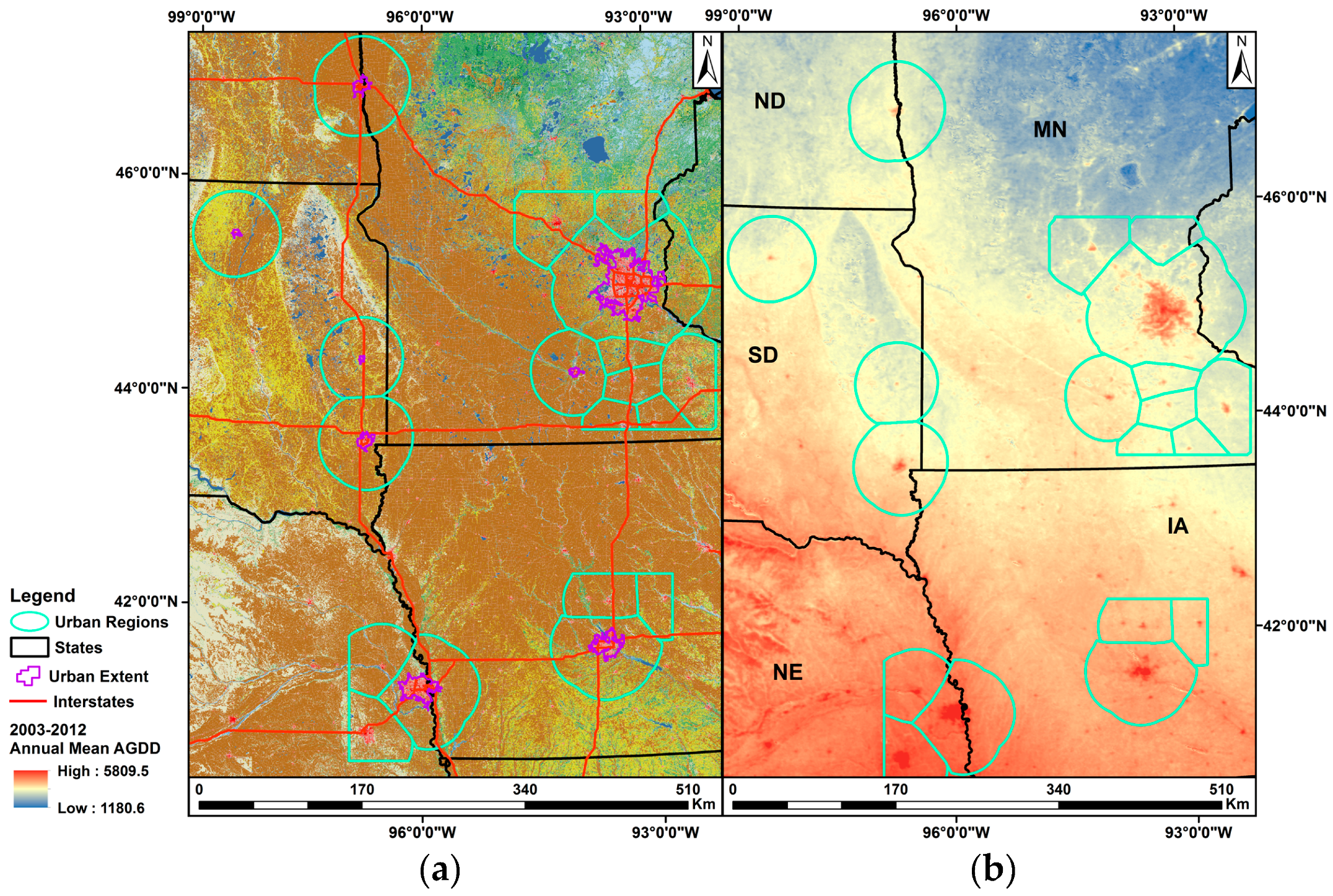
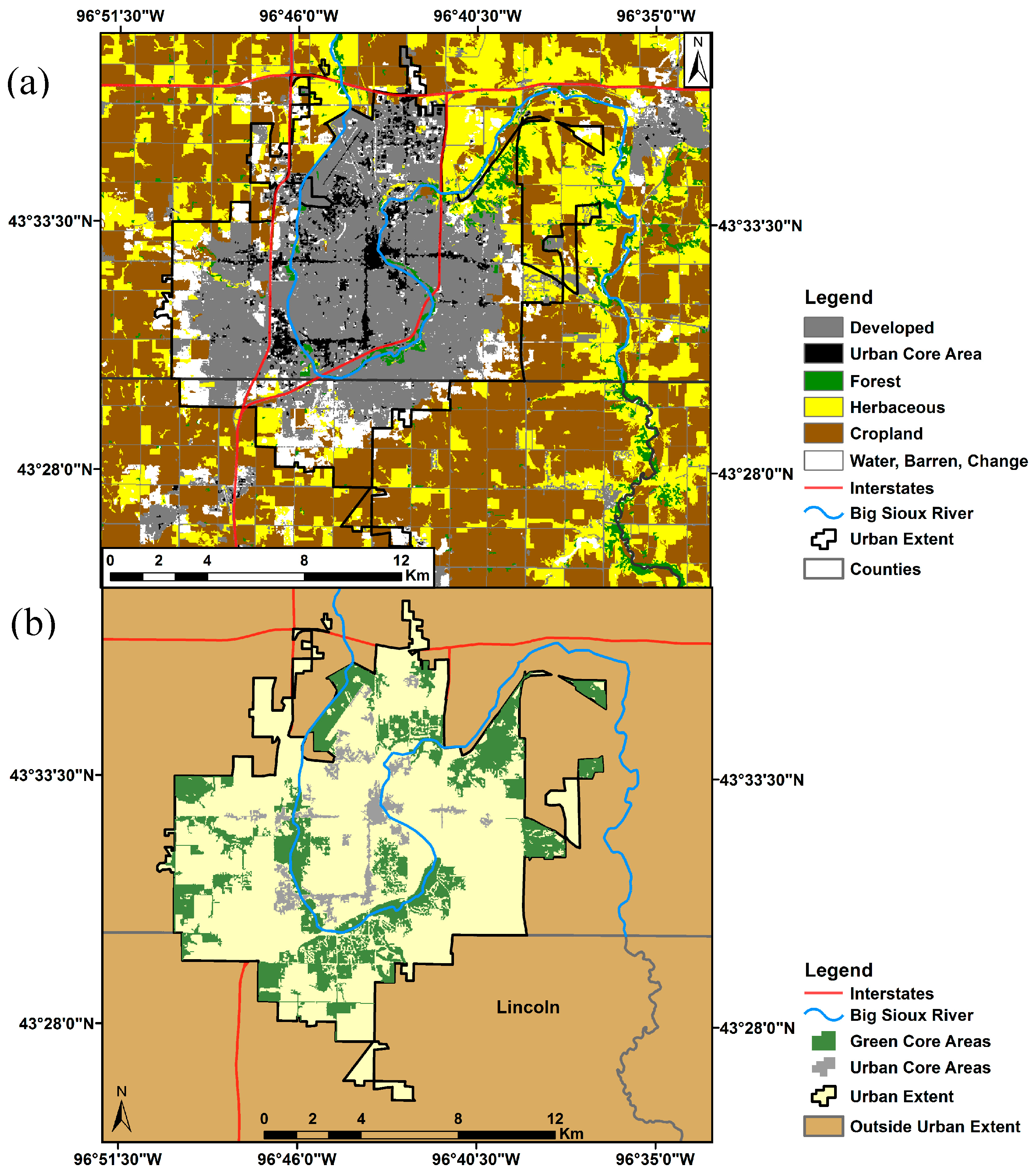





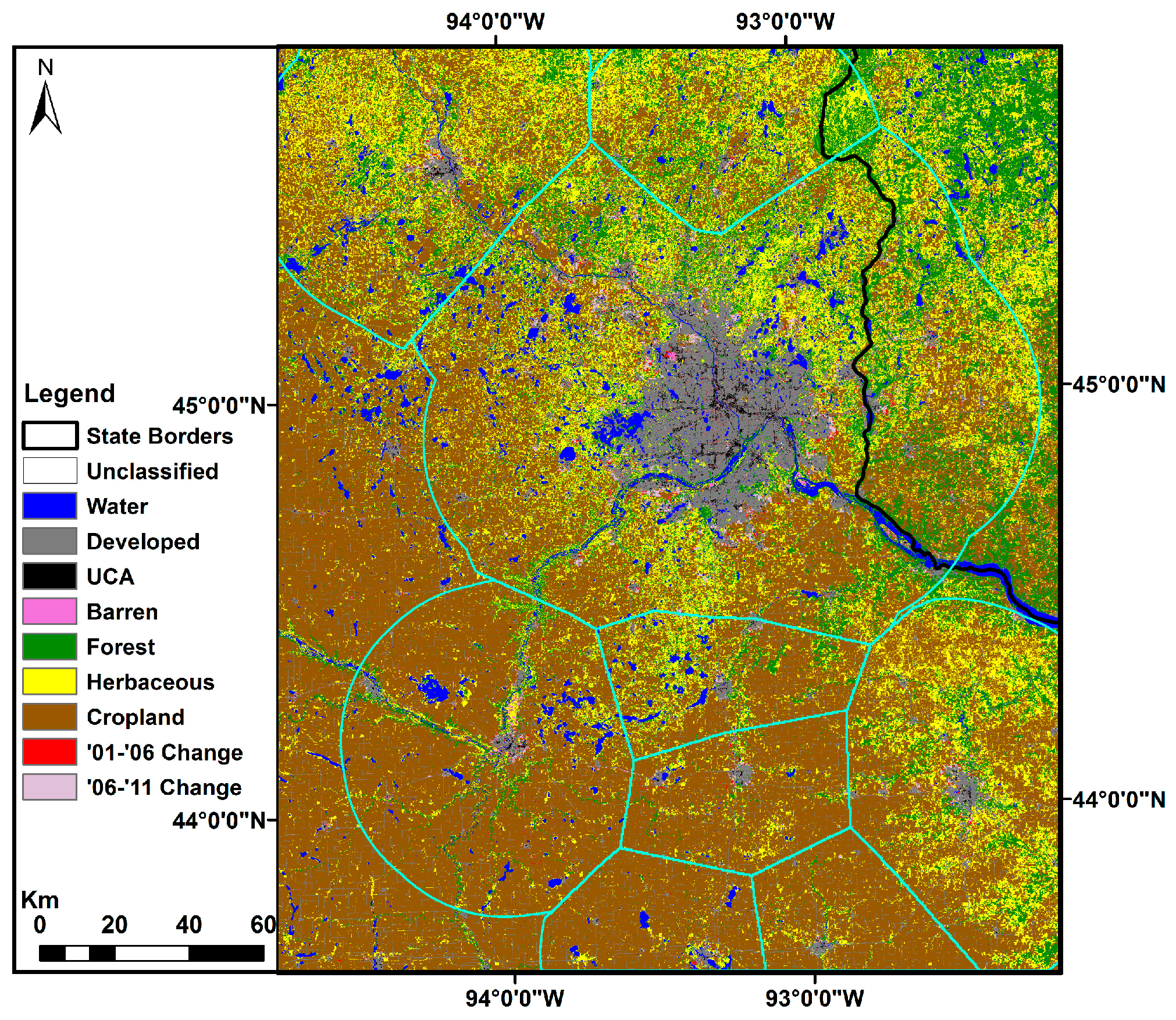
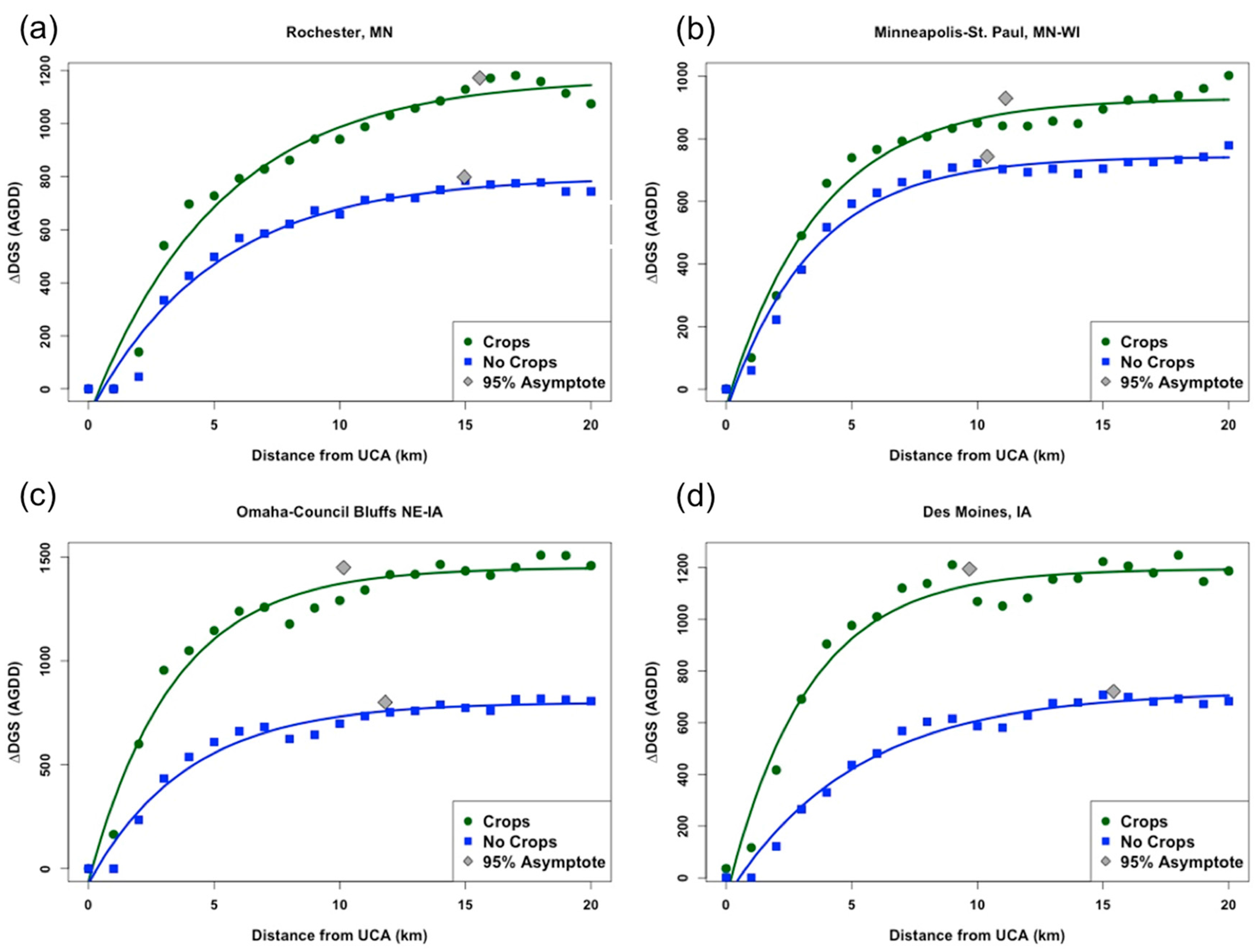

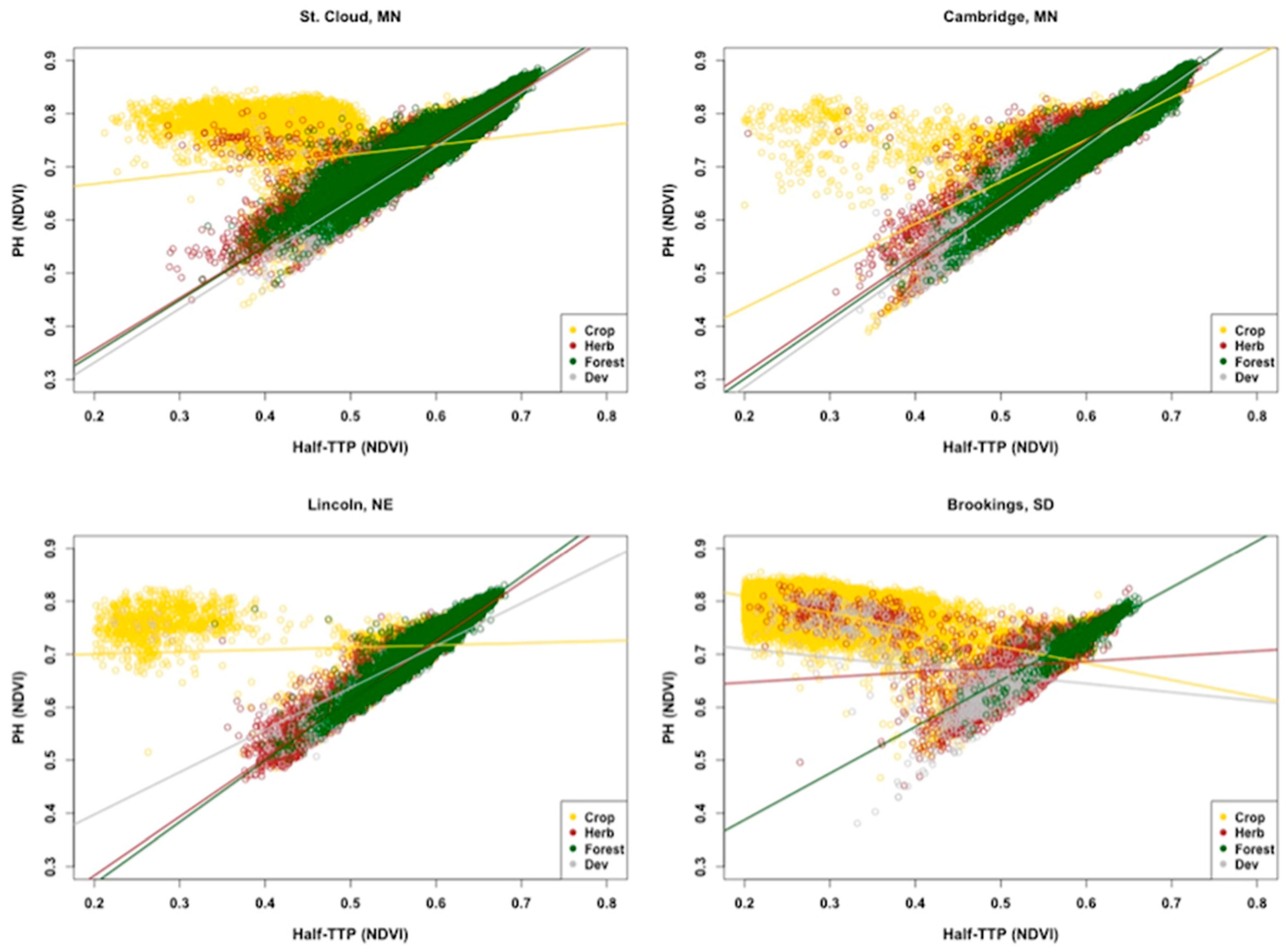
| City | 2011 Pop. | 2010 UE (km2) | Lat | Lon | 2003–2012 AGDD | LSP Model (%) |
|---|---|---|---|---|---|---|
| MSP, MN | 3,388,716 | 2773.3 | 44.98 | −93.28 | 4318 | 66.2 |
| Omaha, NE | 876,836 | 702.4 | 41.23 | −96.03 | 5129 | 72.2 |
| Des Moines, IA | 580,779 | 519.5 | 41.62 | −93.66 | 4889 | 88.4 |
| Lincoln, NE | 306,443 | 229.1 | 40.81 | −96.68 | 5161 | 62.9 |
| Sioux Falls, SD | 232,553 | 166.2 | 43.53 | −96.74 | 4428 | 56.5 |
| Fargo, ND | 212,695 | 182.1 | 46.86 | −96.82 | 3819 | 28.6 |
| Rochester, MN | 208,446 | 131.0 | 44.02 | −92.48 | 4157 | 75.9 |
| St. Cloud, MN | 189,980 | 130.1 | 45.57 | −94.19 | 3918 | 63.8 |
| Mankato, MN | 97,280 | 68.3 | 44.17 | −93.99 | 3867 | 73.6 |
| Ames, IA | 90,834 | 59.8 | 42.03 | −93.63 | 4435 | 80.4 |
| Faribault, MN | 64,908 | 29.5 | 44.29 | −93.28 | 3996 | 82.7 |
| Marshalltown, IA | 40,967 | 29.7 | 42.04 | −92.91 | 4576 | 77.6 |
| Aberdeen, SD | 40,902 | 33.1 | 45.46 | −98.47 | 3780 | 37.8 |
| Austin, MN | 39,320 | 31.7 | 43.67 | −92.98 | 3920 | 83.2 |
| Fremont, NE | 36,943 | 28.2 | 41.44 | −96.49 | 4804 | 73.1 |
| Owatonna, MN | 36,551 | 33.0 | 44.09 | −93.22 | 4035 | 81.2 |
| Brookings, SD | 32,109 | 24.6 | 44.30 | −96.78 | 4008 | 58.3 |
| Albert Lea, MN | 31,111 | 25.5 | 43.65 | −93.37 | 3898 | 67.1 |
| Cambridge, MN | 15,155 | 25.7 | 45.54 | −93.23 | 3833 | 76.3 |
| National Land Cover Database Class | ID | Study Class |
|---|---|---|
| Open Water, Perennial Ice/Snow | 1 | Water |
| Developed: Open Space, Low/Medium Intensity | 2 | Developed |
| Developed: High Intensity | 3 | Urban Core Area |
| Barren Land (Rock/Sand/Clay) | 4 | Barren Land |
| Deciduous, Evergreen, Mixed Forest, Woody Wetlands | 5 | Forest |
| Shrub/Scrub, Grassland/Herbaceous, Pasture/Hay, Emergent Herbaceous Wetlands | 6 | Herbaceous |
| Cultivated Crops | 7 | Cropland |
| Change in Impervious Surface Area: 2001–2006 | 8 | 2001–2006 Change |
| Change in Impervious Surface Area: 2006–2011 | 9 | 2006–2011 Change |
| City | NC b | C b | C u | NC u | C R2 | NC R2 | NC a | C a | ∆a | NC Dist (km) | C Dist (km) |
|---|---|---|---|---|---|---|---|---|---|---|---|
| Aberdeen, SD | 0.233 | 0.204 | 0.887 | 0.848 | 0.904 | 0.857 | 528 | 836 | 309 | 12.9 | 14.7 |
| Albert Lea, MN | 0.243 | 0.251 | 1.151 | 1.174 | 0.934 | 0.879 | 652 | 1135 | 482 | 12.3 | 12.0 |
| Ames, IA | 0.217 | 0.264 | 1.097 | 1.154 | 0.963 | 0.899 | 662 | 1400 | 738 | 13.8 | 11.4 |
| Austin, MN | 0.258 | 0.374 | 0.974 | 0.991 | 0.953 | 0.878 | 689 | 1203 | 514 | 11.6 | 8.0 |
| Brookings, SD | 0.399 | 0.369 | 1.069 | 1.050 | 0.952 | 0.964 | 605 | 1084 | 480 | 7.5 | 8.1 |
| Cambridge, MN | 0.275 | 0.396 | 1.003 | 0.984 | 0.910 | 0.951 | 422 | 482 | 60 | 10.9 | 7.6 |
| Des Moines, IA | 0.195 | 0.310 | 1.065 | 1.109 | 0.961 | 0.975 | 721 | 1195 | 474 | 15.4 | 9.7 |
| Faribault, MN | 0.388 | 0.419 | 1.004 | 1.145 | 0.966 | 0.920 | 545 | 970 | 426 | 7.7 | 7.2 |
| Fremont, NE | 0.253 | 0.373 | 0.777 | 0.970 | 0.970 | 0.933 | 735 | 1467 | 732 | 11.8 | 8.0 |
| Lincoln, NE | 0.276 | 0.317 | 0.792 | 0.900 | 0.944 | 0.968 | 855 | 1303 | 448 | 10.9 | 9.5 |
| Mankato, MN | 0.238 | 0.312 | 1.032 | 1.068 | 0.946 | 0.963 | 393 | 931 | 538 | 12.6 | 9.6 |
| Marshalltown, IA | 0.221 | 0.178 | 0.896 | 1.007 | 0.987 | 0.970 | 804 | 1428 | 623 | 13.6 | 16.8 |
| MSP, MN | 0.289 | 0.270 | 1.058 | 1.094 | 0.975 | 0.975 | 743 | 929 | 186 | 10.4 | 11.1 |
| Omaha, NE | 0.254 | 0.296 | 1.042 | 1.089 | 0.972 | 0.963 | 800 | 1449 | 649 | 11.8 | 10.2 |
| Owatonna, MN | 0.357 | 0.451 | 1.101 | 1.089 | 0.937 | 0.937 | 754 | 1276 | 522 | 8.4 | 6.6 |
| Rochester, MN | 0.201 | 0.193 | 1.090 | 1.124 | 0.966 | 0.966 | 799 | 1172 | 374 | 15.0 | 15.6 |
| Sioux Falls, SD | 0.238 | 0.340 | 1.097 | 1.109 | 0.960 | 0.956 | 832 | 1375 | 543 | 12.6 | 8.8 |
| St. Cloud, MN | 0.532 | 0.527 | 1.065 | 1.085 | 0.924 | 0.940 | 497 | 611 | 115 | 5.6 | 5.7 |
| Minimum | 0.195 | 0.178 | 0.777 | 0.848 | 0.904 | 0.857 | 393 | 482 | 60 | 5.6 | 5.7 |
| Maximum | 0.532 | 0.527 | 1.151 | 1.174 | 0.987 | 0.975 | 855 | 1467 | 738 | 15.4 | 16.8 |
| Mean | 0.281 | 0.325 | 1.011 | 1.055 | 0.951 | 0.939 | 669 | 1125 | 456 | 11.4 | 10.0 |
© 2017 by the authors. Licensee MDPI, Basel, Switzerland. This article is an open access article distributed under the terms and conditions of the Creative Commons Attribution (CC BY) license (http://creativecommons.org/licenses/by/4.0/).
Share and Cite
Krehbiel, C.; Zhang, X.; Henebry, G.M. Impacts of Thermal Time on Land Surface Phenology in Urban Areas. Remote Sens. 2017, 9, 499. https://doi.org/10.3390/rs9050499
Krehbiel C, Zhang X, Henebry GM. Impacts of Thermal Time on Land Surface Phenology in Urban Areas. Remote Sensing. 2017; 9(5):499. https://doi.org/10.3390/rs9050499
Chicago/Turabian StyleKrehbiel, Cole, Xiaoyang Zhang, and Geoffrey M. Henebry. 2017. "Impacts of Thermal Time on Land Surface Phenology in Urban Areas" Remote Sensing 9, no. 5: 499. https://doi.org/10.3390/rs9050499







